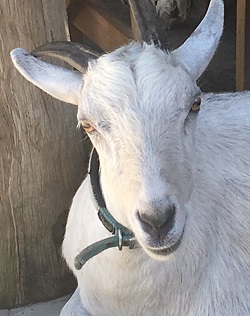Study Livestock Biology
Develop your livestock management skills with this anatomy and physiology course. Study the organ systems of common livestock, and improve overall production quality. Excellent for farmers, animal carers, and those transitioning into animal study.
 If you work with animals and have never studied their biology; this is an important course for you. It is only through a proper scientific understanding of animal anatomy and physiology, that you are going to ever fully understand how animals function, and how you should care for them.
If you work with animals and have never studied their biology; this is an important course for you. It is only through a proper scientific understanding of animal anatomy and physiology, that you are going to ever fully understand how animals function, and how you should care for them.
Course Duration: 100 hours
Course Structure
There are 11 lessons in this course.
-
Introduction to cells & tissues
- livestock classes
- livestock products
- interrelationship between crops and livestock
- cells and tissues
- special properties of cells
- osmosis
- nutrient waste
-
The Digestive System
- digestive system
- mouth, tongue, teeth
- oesophagus
- simple stomach
- small intestine
- large intestine
- ruminant stomach
- accessory organs of the digestive system
- digestion
- absorption and utilisation in the simple stomach
- enzymes
- breakdown by microorganisms
- digestion, absorption and utilisation in the ruminant stomach
- mechanical action
- action of micro-organisms
- utilisation of the end products of digestion
-
The Circulatory System
- circulatory system
- composition of blood
- functions of blood
- clotting mechanism
- immunity
- blood vessels
- arteries
- veins
- capillaries
- physiology of the circulatory system
- heart rate
- spleen
- lymphatic system
- circulatory networks
-
The Urinary System
- anatomy of the urinary system
- kidneys
- ureter
- bladder
- physiology of urinary system
- excretion in different animals
-
The Nervous System
- central and peripheral nervous system
- main parts of the nervous system
- neurons
- sensory neurons
- motor neurons
- central nervous system
- the brain
- spinal cord
- peripheral nervous system
- cranial nerves
- spinal nerves
- autonomic nervous system
- reflex actions
- endocrine system
- structure and function of the ear
- hearing
- structure and function of the eye
- the iris
- structure and function of the nose
-
Respiration
- anatomy of respiration
- trachea
- bronchial tree
- lungs
- physiology of respiration
- gaseous exchange
- rate and depth of breathing
-
The Reproductive System
- anatomy of the male reproductive system
- testes
- accessory organs
- penis
- physiology of male reproductive system
- hormone production
- sperm production
- erection
- ejaculation
- fertility problems in males
- venereal diseases
- other diseases
- injury
- physical immaturity
- emotional immaturity
- nutrition
- poor handling
- anatomy of female reproductive system
- ovaries
- fallopian tubes
- uterus
- cervix
- physiology of the female reproductive system
- ovulation, oestrus cycle
- fertility problems, difficulties conceiving
- venereal and other diseases
- physical abnormalities
- nutrition
- inability to carry a foetus to full-term
- pregnancy and parturition
- fertilisation
- pregnancy
- parturition
- birth process
- difficult births
- structure of the mammary glands
- secretion of milk
- milk ejection
- reproduction data for cows, sows and ewes
-
Muscles & Meat
- muscles and meat
- smooth muscle
- striated voluntary muscle
- cardiac muscle
- structure of meat
- dressing out percentage
- composition of the beef animal
- meat quality and tenderness
- juiciness
- flavour
- cuts and joints of meat
-
The Skeleton
- bones
- how bones are formed
- anatomy of bones
- fractures and fracture healing
- five types of bone
- joints of bone
- the skeleton
- dentition
- the dental formula
- cattle
- dental formula of an ox and cow
- eruption of permanent teeth
- pigs
-
Animal Growth, Development, and the Endocrine System
- growth and development
- growth curve
- prenatal growth
- post-natal growth
- fat
- factors which affect the size of new-borns
- factors affecting post-natal growth
- early maturing
- compensatory growth
- endocrine system
- pituitary gland
- thyroid
- parathyroid
- thymus
- adrenal bodies
- pancreas
- testes
- ovaries
- pineal body
- mucous membrane of the stomach
-
Comparing Different Animals
- poultry
- digestion
- gullet
- crop
- proventriculus
- gizzard
- intestine
- caecum
- rectum
- incubating eggs
- natural incubation
- symptoms of a broody hen
- fish
Enrol Today
Ready to get started? Click on the orange enrol now button.
Have questions? Click here to email our course counsellors.
Do you Understand Muscle Tissue?
There are three kinds of muscle:
- smooth (or involuntary) muscle
- striated (or voluntary) muscle
- cardiac muscle
Smooth Muscle
In animals smooth muscle is found in the walls of the intestines, in the urogenital system and in the blood vessels. It is called involuntary muscle because it works automatically, without any conscious effort by the person or animal. A good example is peristalsis, the muscular contractions and relaxation which move food down the oesophagus and the small and large intestines. Smooth muscle is made up of elongated, spindle-shaped cells with the nucleus placed in the middle of the cell as seen.

Striated Voluntary Muscle
These muscles are made up of bundles of long fibres. Each fibre is a muscle cell. The fibres have many nuclei that are placed near the surface of each cell. Each individual muscle cell is made up of smaller fibres called myofibrils (myo — meaning "muscle" in Greek). A sheath called the sarcolemma holds the myofibrils in a bundle and connects the muscle cell to tendons and gives elasticity. Each muscle fibre is controlled and activated by a branch from a motor neuron from the nervous system.
Under a powerful electron microscope, bands can be seen on each myofibril. This consists of very fine filaments of two proteins, actin and myosin. During the contraction of the muscle, it is believed that the actin filaments slide together so that neither the actin nor the myosin filaments actually change their lengths. The contraction of muscles is a positive action and requires energy to be carried out.
When you pick up a brick, the muscles of the arm and fingers contract as you grip the brick and the arm muscles contract as you lift the brick upwards. You can drop the brick by relaxing the arm and finger muscles. Throwing the brick requires more contraction of the muscles and a greater supply of energy. This energy is supplied as a result of a number of chemical reactions which take place inside the muscles.
One such reaction is the breakdown of a substance called Adenosine Tri-Phosphatase (or ATP). The protein filaments of myosin act as an enzyme to break down ATP to ADP (Adenosine Di-Phosphatase) and phosphoric acid. This reaction releases a great deal of energy which is used by the muscle fibres to cause contraction. As long as ATP is being broken down the muscle remains active, but when this reaction stops, the muscle becomes relaxed. Another reaction is the breakdown of glycogen into lactic acid with the production of energy.
Cardiac Muscle
This type of muscle is striated (or striped) and is involuntary. It differs from striated voluntary muscle in the following ways:
- the nuclei are placed in the centre of the cells
- the fibres branch out to form networks
- between the cells there are membranes called intercalated discs
- not subject to fatigue in the way that striated voluntary muscle becomes tired and less effective